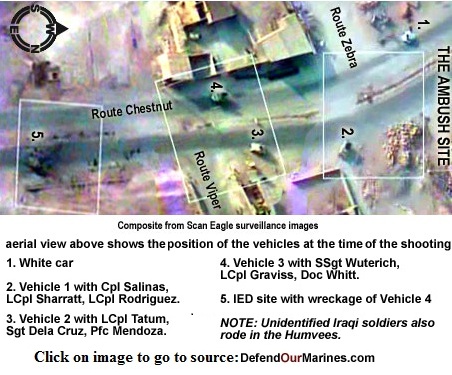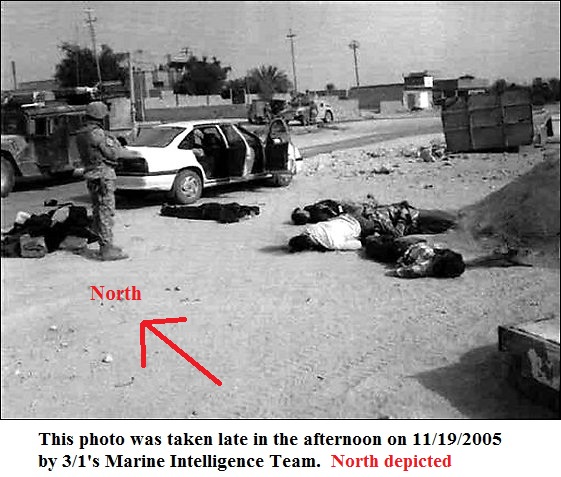United States Marine Staff Sergeant Frank Wuterich stands accused of 9 counts of voluntary manslaughter, 2 counts of assault with a dangerous weapon, 3 counts of dereliction of duty, and “responsible for the deaths of 19 civilians” in Haditha, Iraq. The trial is expected to take four weeks. The prosecution began its case last Monday. What follows is key testimony that the media has failed to report and my analysis of the trial to date. [Note: This analysis was updated on January 17, 2012.]
The ambiguous Rules of Engagement card carried by our Marines that day included these requirements: “Do not fire into civilian populated areas or buildings unless the enemy is using them for military purposes or if necessary for your self-defense. Minimize collateral damage.” Near its end, it correctly defined the mission: “Attack enemy forces and military targets. Spare civilians and civilian property, if possible.”
Tuesday, LCpl Stephen Tatum testified:
Tatum acknowledged the night before the convoy his squad had been briefed to expect trouble. They were warned to watch out for snipers active everywhere in Haditha and the infamous white cars that insurgents were using as Vehicle Borne Improvised Explosive Devices (VBIEDs).
SSgt Wuterich and Sgt Sanick Dela Cruz were undoubtedly at the mission briefing. White cars would be on their minds the next morning — November 19, 2005 — when Kilo Company, 3rd Battalion, 1st Marine Regiment was at war. [Update 7:25 PM: LT Kallop also testified that he conducted the mission briefing; Wuterich and Dela Cruz were present.]
On Friday, LT William Kallop, Kilo Company’s 3rd platoon and quick reaction force (QRF) leader testified:
He told the eight member panel that intelligence reports rolling in prior to the ambush indicated that the al Qaeda-led insurgency was regrouping around Haditha to try and reestablish control of the embattled region. “There was fire around the city at this time. One time Iraqi soldiers fired and told us they saw insurgents running. One of our Marines had shot an individual running,” Kallop told prosecutor Maj. Nicholas Gannon. [I will return to his testimony during my analysis of the counter-attack upon houses 1 and 2.]
3/1 took over the 90,000-person city of Haditha without firing a shot in early October 2005. Over the next 6 weeks, they discovered and eliminated 190 IEDs, and sent two-dozen suspected insurgents off to higher HQs for interrogation. (Also see Al Qaeda in Haditha: The Battle the Media Ignored.) On October 7, 2005, CNN reported, “The city itself is almost literally an improvised explosive device (IED) field.” Indeed. The company that K Co 3/1 replaced the previous month sustained the highest percentage of casualties of the entire Iraq War: 26 Lima Company 3/25 Marines were dead and another 32 had been wounded. (Also see The Battle of Haditha.)
Ambush on Route Chestnut
An eerie quiet was broken at 7:15 a.m. on November 19. 2005. A white car carrying 5 military-aged men (MAMs) had approached SSgt Wuterich’s 4-Humvee resupply convoy from ahead and been waived to give way by LCpl Justin Sharratt who was manning his M240G Machine Gun in the lead Humvee’s turret. The white car stopped off to the side, inside the squad’s security perimeter, just as a buried IED was set off beneath the last Humvee in the convoy, splitting the vehicle and LCpl Miguel “TJ” Terrazas in half, and wounding Lance Corporals James Crossan and Salvador Guzman. The blast initiated an ambush and the squad immediately came under small arms fire. Every Marine’s weapon was not immediately turned on the white car — the five men inside it were not immediately turned into goo. SSgt Wuterich had to rapidly make a threat assessment, secure the squad’s defensive perimeter, suppress enemy fires, and defend his Marines caught in that kill zone.
The enemy’s complex attack would soon embroil all of Kilo Company, leave 1 Marine dead, and wound 10 Marines and 1 Navy Corpsman.
SSgt Wuterich had spotted the white car stopped ahead of him. He followed his training. First he radioed higher HQs of the attack, reported his casualties, and requested that the QFR respond to his location. [Correction made January 17, 2012: As Wuterich was driving, LCpl Graviss actually radioed-in the initial report and he overheard it. Wuterich radioed-in a second report soon after the encounter with the white car.] He dismounted the 3rd Humvee and approached the white car from the east with his M-16 at the ready.
Wuterich has previously stated that when he was still more than 30 meters away, three MAMs dismounted to the south from the passenger side, and the other two dismounted to the north, from the driver’s side, moved west away from him, and then turned south around the back of the white car. He saw that Sgt Dela Cruz was north across the road, heard him shouting commands at the five, and the men were not complying. A chest-high dirt pile was but a few feet south of them and in the direction the five were moving.
LCpl Tatum, Cpl Hector Salinas, and Navy Corpsman HN1 Brian Whitt rushed from their Humvees, under enemy fire, to the stricken vehicle.
Salinas testified Thursday that as he passed close behind Dela Cruz, he saw him aiming his M-16 at the five MAMs, and heard him shouting “Stop! Stop!” at them in Arabic. As Nat Helms reported, Dela Cruz’s testimony Wednesday seemed incredible:
It is either the fourth or fifth version of his observations since he failed a polygraph, and then elected to accept immunity from prosecution, counting the two versions he presented at trial today. … “They were standing there looking around, some with their hands in the air and some behind their heads,” Dela Cruz said while demonstrating the decedent’s movements. “One of the Iraqis in the middle dropped, sir. Then they were falling back behind the car. I looked over at Sgt. Wuterich – Sergeant Wuterich was kneeling in a firing position, sir. I looked back at the Iraqis and I didn’t see [any] more of them.”
Why would Dela Cruz have shouted “Stop! Stop!” in Arabic at the five if, “They were standing there looking around?”
Those Marines had been trained on defending against VBIEDs and reminded the night before on how to identify them on the battlefield. If they perceived a vehicle and those inside it as threats, they were to engage the occupants before the device could be set off and from a distance.
SSgt Wuterich perceived a threat and engaged it by fire.


